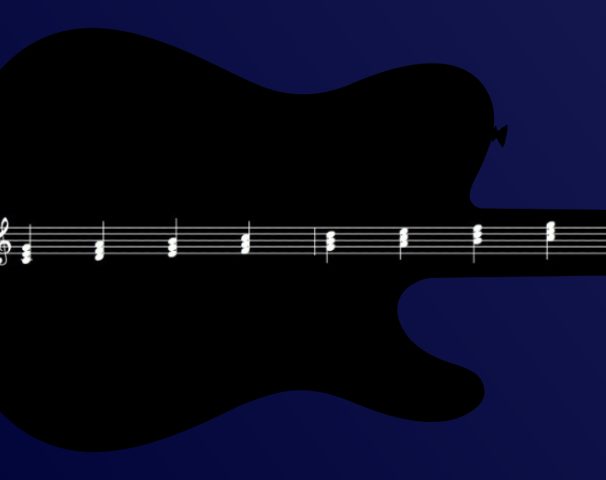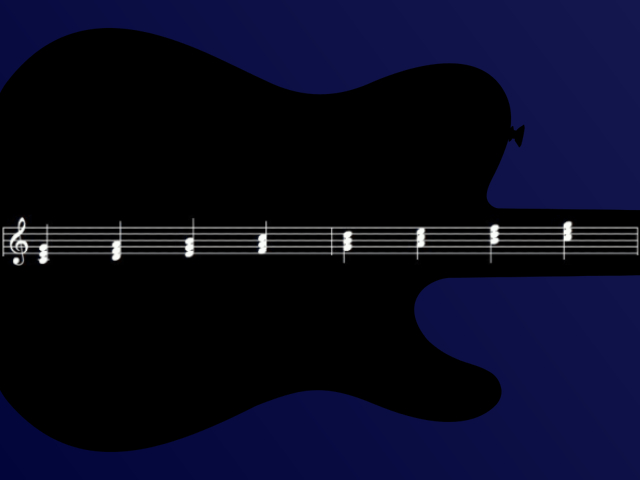
The term harmonized scale sounds complicated, but it’s really a very simple concept. Simple, but powerful. When I first learned about the harmonized scale (somewhere around 30 years into my playing career), I was surprised at how much knowledge it unlocked for me.
I had picked up pieces of it along my journey, and had some basic knowledge of it. But I didn’t have any real understanding of it. I didn’t even know it was a thing, to be frank.
All I knew was that some things worked, but I didn’t know why they worked. I knew that some chords sounded better together than others. But I didn’t know why. The harmonized scale explained a lot of what I knew already. More importantly, it unlocked a ton of potential that I had no clue about.
What is the harmonized scale?
In music, the harmonized scale is a series of chords based upon each note of the scale in succession. You start with each successive note in the scale and build chords by combining two intervals of a third above the starting note where all notes of the chord belong to the scale. This results in a list of seven chords, each of which contains only scale notes. When done with a major scale, the first, fourth, and fifth chords are major chords. The second, third, and sixth chords are minor chords. Finally, the seventh chord is a diminished chord. Each of these seven chords fits nicely in a piece of music played in the key from which the scale was derived.
How do you determine the chords in the harmonized scale?
At first, figuring out the chords in the harmonized scale will likely feel a bit daunting. But it’s really quite simple, and once you understand the basic idea, you will quickly be able to find the chords for any scale.
So, let’s start with the basic mechanics so you understand how it works. But don’t get bogged down by the details. Once you understand this, you’ll never again have to piece it together as we will here.
How to construct the harmonized scale
We’ll work with the major scale here. You have to understand the major scale for this discussion.
You also need an understanding of intervals. We’re going to work with triads. Each half of these triads is built by skipping an interval of a third from one note of the chord to the next. Those third intervals will either be major or minor.
Need help with the major scale and intervals?
For instance, if we start with the key of C major, the first chord is C major. Start with the root note C. We now need the third interval. Remember, the harmonized scale contains only notes from the scale. So this first third interval has to be a major third in order to land on a scale note, in this case the note E. From E we go another third up. This time we have to land on a minor third interval in order to hit the scale note G. A major third would land us on G# which is not in the C major scale.
To find the next chord of the harmonized scale, we simply move to the second note in the scale and repeat the process. In the key of C, the second note of the scale is D.
Start with D and move up a third. In this case, it has to be a minor third in order to land on the scale note F. From F we need to move a major third to land on A. So we get the notes D, F, and A. And that’s a D minor chord. Thus, the second chord in the C major harmonized scale is D minor.
We could continue with this for the remaining five chords, but hopefully you get the technique.
You can also harmonize the minor scale. Learn how at
The harmonized scale in C major
The piano keyboard gives us the most visual way to understand the harmonized scale. And the key of C major provides the best place to start since it uses only white piano keys in its scale.
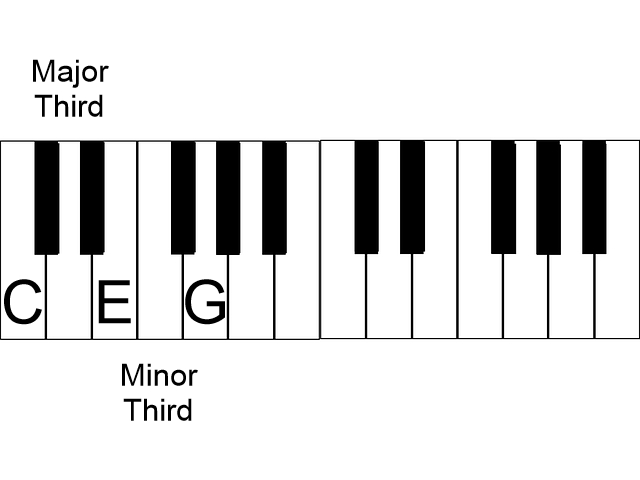
If you have a piano or other piano-like keyboard, go to it and make a C major triad. Make note of the shape of that chord. Assuming you use your right hand, your thumb plays the C note. Then you skip a white key. Your middle finger plays the next white key, which is E. Skip another white key. Finally your pinky plays the next white key, the G.
As we stated above, the interval from C to E is a major third. Notice that you count a total of four keys (both black and white) from C to E. The interval from E to G is a minor third with just three keys from E to G.
To easily and quickly find the rest of the chords in the harmonized scale for C major, just move that finger shape up one key at a time. So thumb to D, middle to F, and pinky to A.
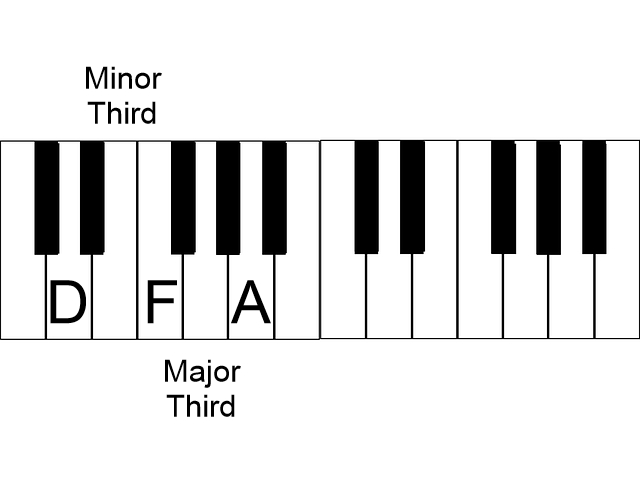
The shape stays the same. But the interval construction switches. There are now only three keys from the first to the second note of the chord and four from second to third. That makes this a minor chord. Specifically, because D is in the root, this is a D minor chord.
Move the shape up another key and now you have E minor. Up another key for F major. Another key for G major. And move up once more and notice that you have A minor.
So, up to here we know that the chords of the C major harmonized scale are:
C, Dm, Em, F, G, Am
The last chord is B diminished, or Bdim.
What is a diminished chord?
A diminished chord is formed by combining two minor third intervals. From the root note of the chord, move a minor third interval to the second note. From the second note, move another minor third to the third note of the chord. You could say that a diminished chord is half major and half minor, so it is really neither. Diminished chords have a particularly unsettled sound and feeling that strongly suggest resolution to a more comfortable major or minor chord.
You’ve now discovered six of the seven chords in the C major harmonized scale. The seventh chord is a little bit special.
Move the shape up one more key so that the root of the chord sits on the note B. keeping the shape and still skipping one white key between each note, you have the notes D and F.
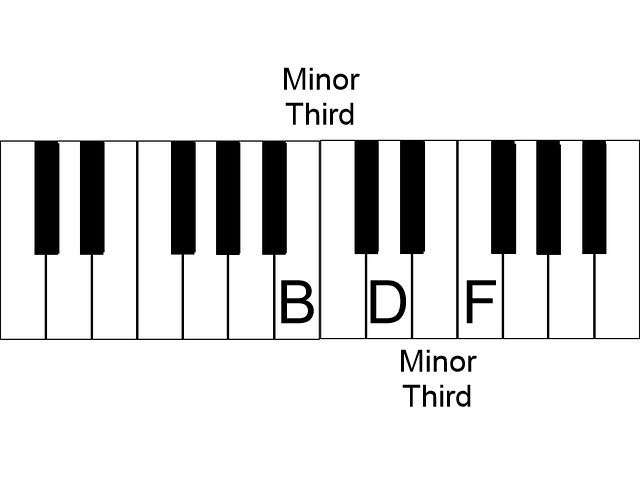
So what is this chord? We know that a chord that has a major third followed by a minor third is a major chord. And we know that a minor third followed by a major third creates a minor chord.
But what kind of chord is it when a minor third follows another minor third? That’s called a diminished chord. So the last chord in the C major harmonized scale is B diminished.
Diminished chords are used far more often in genres like jazz and perhaps funk and blues. They’re used less frequently in genres such as folk and country.
The harmonized scale in A major
The key of C major works perfectly for demonstrating this concept because it uses only white keys. But the same system works for any key. Let’s try it quickly in A.
The notes of the A major scale are:
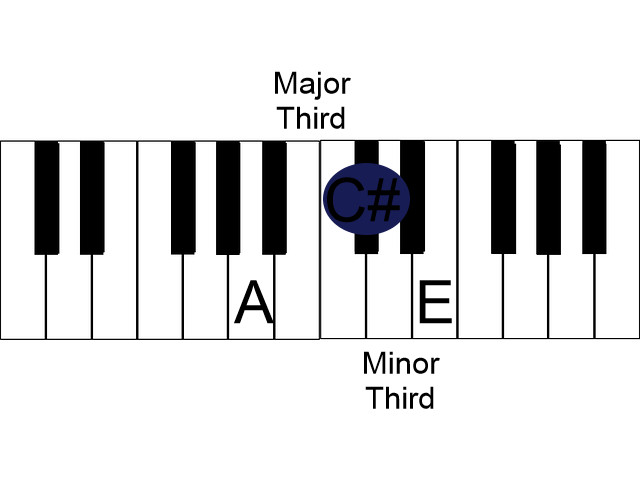
A, B, C#, D, E, F#, G#
So we know that the chords in the harmonized scale can use only those notes. Looking at the piano keyboard again we see that the root chord A has the notes A, C#, and E. So it includes one black key…the C#.
But it still has the major third on the bottom and the minor third on the top. So it’s a major chord.
The next chord contains the notes B, D, and F#. That’s a B minor chord because B is the root, the minor third is in the bottom half, and the major third in the top half.
If you were to continue on, you would find that the seven chords of the A major harmonized scale are:
A, Bm, C#m, D, E, F#m, G#dim
A key result of constructing the harmonized scale
If you look back at the chords of these two major harmonized scales, you’ll notice a similarity. And this is a critical thing for you to know:
In every major-key harmonized scale, the I, IV, and V chords are major chords. The II, III, and VI chords are all minor. And the VII chord is diminished. No matter what key you’re in, this remains the case always.
This information is incredibly useful because now you don’t need to work out each chord in any major harmonized scale note by note. All you need to know are the notes of the scale. Once you know that, you nearly automatically know the seven harmonized scale chords of that key.
For instance, take any random major key. Let’s say the key of B flat as an example. The notes of the B flat major scale are:
Bb, C, D, Eb, F, G, A
Now that we know that, we can instantly name the three major chords in the harmonized scale: Bb, Eb, and F. And we can just as quickly name the three minor chords: C, D, and G. Finally, we know that the A is diminished.
So, the chords of the Bb harmonized scale in order are:
Bb, Cm, Dm, Eb, F, Gm, Adim
Simple as that. And it works for every key. If you’ve done your homework on major scales and chord shapes, you can play the harmonized scale in any key.
Need help with chord shapes? Start with
Why is understanding the harmonized scale important?
The harmonized scale is far more than just a neat parlor trick or fun musical trivia. It’s incredibly useful music theory knowledge to possess for several reasons.
The harmonized scale helps you determine the key of a song
First, you can use your knowledge of the harmonized scale to accurately determine the key of a song. For instance, if you play a song that contains the chords A, D, and E, then there’s a likely chance that the song is in the key of A.
If you encounter a song that has the chords G, Am, Em, and D, then you’re likely looking at a piece of music in the key of G. How do you know? In the key of G, G is the root, D is the V, Am is the II, and Em is the VI.
However, be careful. In this case, the song could also be in the key of Em. In that key, Em is the root, Am is the IV, D is the II, and G is the VI. You might know that Em is the relative minor of G major, so it follows that the two keys have the same chords.
Need to study up on the concept of relative minor?
So, knowing the chords isn’t a foolproof way of knowing what key you’re in, but it works most of the time and it certainly narrows the possibilities in other cases.
Determine the most likely chords in a song
Another powerful result of your knowledge of the harmonized scale enables you to predict what chords likely appear in any song.
Say you’re in a jam situation with some friends. A guy says, “This one’s in D!” and off he goes.
If you’re not familiar with the song, you could be quite lost without the harmonized scale. But with it, you can quickly narrow down the likely chords in the song to the seven harmonized chords. Since in reality many popular songs contain only three to five chords, you have a great shot at getting up to speed pretty quickly.
You know the notes of the D major scale are D, E, F#, G, A, B, and C#. So you quickly deduce that seven chords likely to be used in this song are D, Em, F#m, G, A, Bm, and C#dim.
You might not get all the chords right instantly if the song throws some curveballs, but you’re likely to get close enough to play along until a friend helpfully tells you what you’re missing. And that’s a way better feeling than being completely lost.
Learn songs more quickly by ear
Similar to the benefit I just outline above, understanding the harmonized scale helps you to figure out the chords of any song by ear.
Say you’re trying to learn a favorite song. You’ve figured out that the song contains a C chord and a G chord. You know that C is the root of C major and G is the V. So, you can proceed under the assumption that the song is in the key of C.
With that assumption in mind, you know which other five chords of the C harmonized scale you should look for in the song. This is like a headstart in figuring out all the chords of the song.
Again, it isn’t foolproof, and you could go down a few wrong paths. But it provides some important clues for you as you work to piece together the puzzle of a song’s chord progression.
Understand which notes to use in your solos and lead lines
As a lead guitarist, if you understand the harmonized scale, you can more quickly grasp what chords you’re soloing over. This in turn helps you decide what scale patterns you might want to use over different sections of the song.
You know to expect the possibility of three major and three minor chords in the song. Say you’re attempting to follow the changes in your solo. With this knowledge you have a better understanding of when you might want to switch between major and minor pentatonic scale patterns.
Don’t know how to follow the changes when you play lead guitar?
Find the right chords for your songs
As a songwriter you may have come up with a brilliant melody. Now you just need to figure out what chords to use in accompanying yourself on guitar.
It’s usually easy enough to find the root chord you should use. And that usually makes the song’s key obvious.
But perhaps your melody takes a turn in the bridge section and you need to know what chords work there. Assuming the bridge doesn’t change keys, it’s a good bet that one of the other six harmonized scale chords gives you exactly what you need.
You don’t have to guess about which chords sound good in a given key. Those seven chords will each sound great as long as they match what the melody calls for. This is a huge help to you as a songwriter.
To learn how to easily locate the chords of the harmonized major scale on your guitar, read
Conclusion
The harmonized scale gives you seven chords for any key. These chords all use the notes of the scale exclusively. In any key there are three major chords, three minor chords, and one diminished chord.
The positions of the chord in the scale determines whether a chord is major, minor, or diminished, and the order is consistent regardless of the key. Once you know that order, you can nearly instantly identify the seven chords of the harmonized scale in any key.
Understanding the harmonized scale provides critical benefits. It helps you understand the chord structure of any song. You can use it to figure out songs by ear more quickly. Lead guitarists can use the knowledge to help them choose what scales and notes to play.
For something so easy to learn, the harmonized scale is surprisingly packed with useful information.
